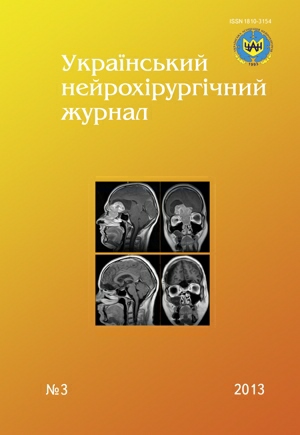«Damage control» at severe polytrauma: neurosurgical aspects
DOI:
https://doi.org/10.25305/unj.54149Keywords:
traumatic brain injury, polytrauma, «Damage control»Abstract
Purpose: to estimate results of «Damage control» principles application in surgical treatment of patients with traumatic intracranial hematomas at severe polytrauma.
Materials and methods. In the research 43 patients were included aged in average (45.5±17.6) years, there were 36 men and 7 women. Wakefulness according to GCS was (6.2±1.4) points, state according to ISS scale — (54.3±8.2) points. As a comparison group we examined 41 injured persons, been treated using standard methods according to the Guidelines for Treatment of patients with Severe Traumatic Brain Injury (2007).
Results. Intraoperative mortality in the main group was 7.3%, in the comparison group — 30%. Using «Damage control» principles reduced mortality in the main group — up to 60.9% that was significantly lower than group of comparison (92.5%) and mortality rate, estimated according to APACHE II scale (P<0,05).
Conclusions. We have modified the technology «Damage control», which is applied for the treatment of 43 patients with severe concomitant traumatic brain injury. It is possible to improve the results of treatment.References
1. Frayerman AP, Kravets LYa, Sheludyakov AYu. Sdavleniye golovnogo mozga pri izolirovannoy i sochetannoy cherepno-mozgovoy travme [Compression of the brain in isolated and combined brain injury]. Nizhniy Novgorod: OOO Tipografiya “Povolzh'ye”;2008. Russian.
2. Nicola R. Early total care versus damage control: current concepts in the orthopedic care of polytrauma patients. ISRN Orthopedics. 2013;2013:1-9. [CrossRef] [PubMed]
3. Pape H-C. Damage control management in the polytrauma patient. New York: Springer; 2010.
4. Stone H, Strom P, Mullins R. Management of the major coagulopathy with onset during laparotomy. Annf Surg. 1983;197(5):532-5. [CrossRef] [PubMed]
5. Verbeek DO, Sugrue M, Balogh Z, Cass D, Civil I, Harris I, Kossmann T, Leibman S, Malka V, Pohl A, Rao S, Richardson M, Schuetz M, Ursic C, Wills V. Acute management of hemodynamically unstable pelvic trauma patients: time for a change? Multicenter review of recent practice. World J Surg. 2008 Aug;32(8):1874-82. [CrossRef] [PubMed]
6. Sagraves SG, Toschlog EA, Rotondo MF. Damage control surgery - the intensivist's role. J Intens Care Med. 2006 Jan-Feb;21(1):5-16. [PubMed]
7. Sokolov VA. Mnozhestvennyye i sochetannyye travmy [Multiple and associated injuries]. Moscow: GEOTAR-Media; 2006. Russian.
8. Giannou C. War surgery. Working with limited resources in armed conflict and other situations of violence. Geneva: ICRC; 2009:1.
9. Brain Trauma Foundation; American Association of Neurological Surgeons; Congress of Neurological Surgeons. Guidelines for the management of severe traumatic brain injury. J Neurotrauma. 2007;24 Suppl 1:S1-106. [PubMed]
Downloads
Published
How to Cite
Issue
Section
License
Copyright (c) 2013 Alexey Trofimov, Oleg Voennov

This work is licensed under a Creative Commons Attribution 4.0 International License.
Ukrainian Neurosurgical Journal abides by the CREATIVE COMMONS copyright rights and permissions for open access journals.
Authors, who are published in this Journal, agree to the following conditions:
1. The authors reserve the right to authorship of the work and pass the first publication right of this work to the Journal under the terms of Creative Commons Attribution License, which allows others to freely distribute the published research with the obligatory reference to the authors of the original work and the first publication of the work in this Journal.
2. The authors have the right to conclude separate supplement agreements that relate to non-exclusive work distribution in the form of which it has been published by the Journal (for example, to upload the work to the online storage of the Journal or publish it as part of a monograph), provided that the reference to the first publication of the work in this Journal is included.









